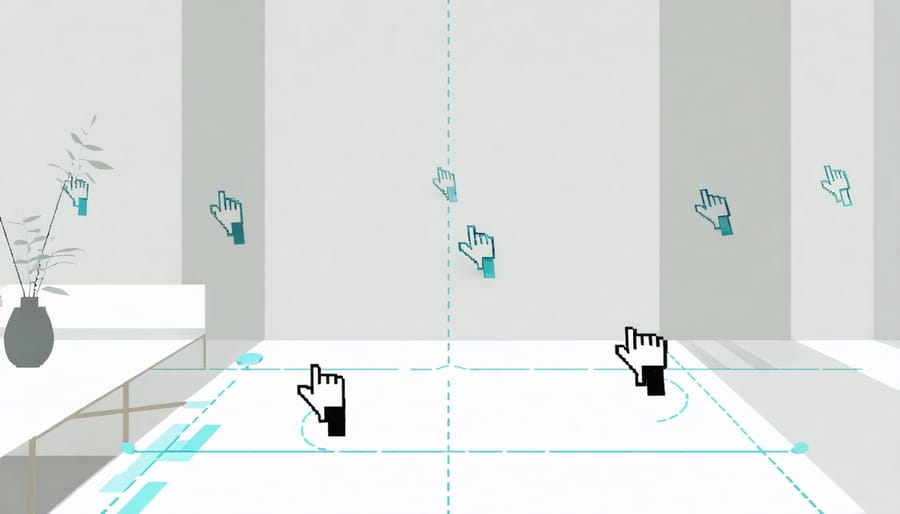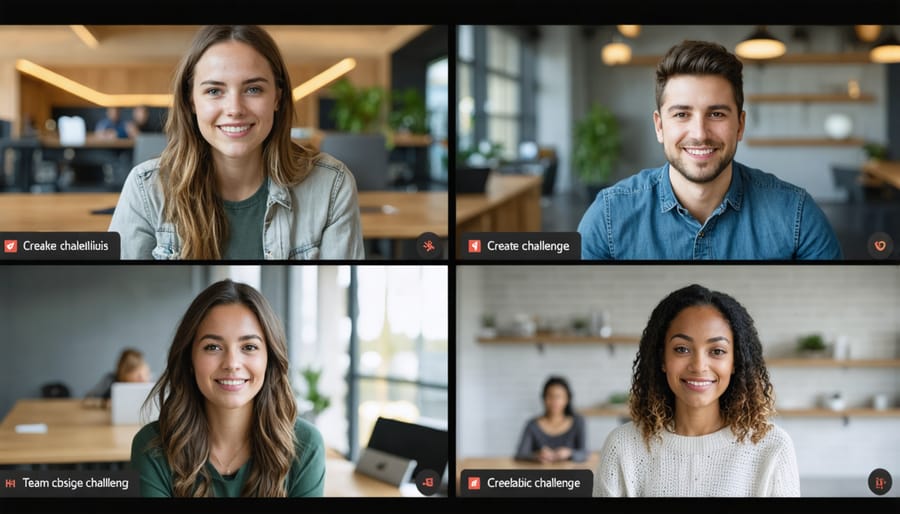
Remote Team Success: Building Strong Virtual Teams for Interior Design Projects
Building effective remote teams demands strategic leadership and intentional connection. Establishing remote design team solutions requires both technological savvy and emotional intelligence. Today’s virtual workplace challenges traditional team-building approaches, yet offers unique opportunities for innovation and collaboration.
Transform your remote team dynamics with seven field-tested strategies that blend digital tools with human-centered practices. These approaches have been specifically developed for Western Governors University (WGU) teams but apply universally to virtual collaborations. Whether managing design projects, coordinating cross-functional teams, or fostering creative partnerships, these methods create lasting connections and drive measurable results.
From establishing clear communication protocols to implementing virtual team-building exercises, each strategy addresses the core challenges of remote collaboration while maintaining team cohesion and productivity. Learn how successful WGU teams navigate the virtual landscape while building strong, resilient working relationships that drive project success.

Virtual Team Communication Foundations
Selecting the Right Communication Tools
In today’s digital workspace, selecting the right communication tools can make or break your team’s success. For interior design teams, a combination of visual collaboration platforms and project management tools is essential. Platforms like Asana or Trello help track project milestones and deadlines, while tools like Miro or FigJam enable teams to collaborate on design boards virtually.
Video conferencing solutions like Zoom or Microsoft Teams are crucial for conducting virtual design consultations and team meetings. These platforms offer screen sharing capabilities, perfect for reviewing design mockups and gathering immediate feedback.
For quick communications, messaging apps like Slack create dedicated channels for different projects, allowing team members to share updates and inspiration in real-time. Cloud storage solutions such as Google Drive or Dropbox ensure everyone has access to the latest design files and project documentation.
Remember to choose tools that integrate well with each other and match your team’s technical comfort level. The goal is to streamline communication, not complicate it with too many different platforms.
Creating Communication Guidelines
Clear communication is the foundation of any successful team, especially in today’s digital workspace. Start by establishing a central communication hub, such as Slack or Microsoft Teams, where all team members can easily connect and share updates. Create specific channels for different project aspects, keeping conversations organized and searchable.
Set expectations for response times and availability windows, considering team members in different time zones. Implement a standard format for project updates, including essential details like progress reports, roadblocks, and next steps. This consistency helps everyone stay aligned and reduces confusion.
Encourage the use of video calls for complex discussions and weekly check-ins to maintain personal connections. Document all important decisions and action items in a shared space, making it easy for team members to reference later. Consider creating templates for common communications like status reports or meeting agendas to streamline information sharing.
Remember to establish guidelines for urgent matters, including preferred contact methods and expected response times for time-sensitive issues. These clear protocols help prevent miscommunication and ensure smooth project flow.
Digital Collaboration Spaces
Virtual Design Studios
Virtual design studios create a collaborative digital environment where team members can work together seamlessly on design projects, regardless of their physical location. Using platforms like Miro, Figma, or AutoCAD online, teams can share designs, provide real-time feedback, and make collaborative decisions about project elements.
These digital workspaces feature virtual whiteboards, annotation tools, and shared document capabilities that mirror the functionality of traditional design studios. Team members can upload material samples, create mood boards, and mark up floor plans together, fostering a sense of shared creativity and purpose.
To maximize the effectiveness of virtual design studios, establish clear guidelines for file organization and feedback protocols. Schedule regular virtual design reviews where team members can present their work and receive constructive criticism. This approach not only maintains project momentum but also strengthens team bonds through shared creative experiences.
Consider implementing “virtual coffee breaks” during design sessions, where team members can casually discuss their work and share inspiration, mimicking the organic interactions that naturally occur in physical studios. This combination of structured collaboration and informal connection helps build stronger, more cohesive virtual design teams.
Project Visualization Tools
Modern team collaboration has been revolutionized by 3D visualization tools, making it easier than ever for remote teams to work together effectively on design projects. These powerful platforms allow team members to create, share, and modify 3D models in real-time, ensuring everyone stays on the same page regardless of their physical location.
By implementing visualization software, teams can conduct virtual walkthroughs, make instant design adjustments, and spot potential issues before they become costly problems. This technology particularly shines during client presentations, where teams can showcase their ideas with stunning clarity and make modifications on the fly based on feedback.
Popular tools like SketchUp, Revit, and Blender offer collaborative features that enable multiple team members to work on the same project simultaneously. To maximize these tools’ effectiveness, establish clear protocols for file sharing, version control, and feedback loops. Consider scheduling regular virtual design reviews where team members can present their work and receive immediate input from colleagues.
Remember to provide adequate training and support to ensure all team members are comfortable using these visualization platforms. This investment in technology and training typically pays off through improved efficiency and higher-quality deliverables.

Building Trust and Connection
Building trust in a virtual team environment requires intentional effort and consistent communication. Start by establishing regular one-on-one check-ins with team members, creating a safe space for open dialogue about both work and personal challenges. These conversations help bridge the digital divide and create genuine connections that strengthen team bonds.
Implement virtual coffee breaks or informal team gatherings where members can chat casually about non-work topics, just as they would in a physical office kitchen. These moments of authentic interaction help team members see each other as real people, not just faces on a screen.
Create opportunities for shared experiences through virtual team activities. Consider organizing online workshops where team members can collaborate on design projects, share their workspace setups, or discuss their favorite home improvement techniques. These activities not only build camaraderie but also enhance professional relationships.
Transparency is crucial in remote settings. Use project management tools to maintain clear visibility of everyone’s contributions and progress. Celebrate individual and team achievements publicly, whether it’s completing a challenging renovation project or mastering a new design software.
Foster psychological safety by encouraging all team members to voice their ideas and concerns without fear of judgment. When someone shares a suggestion for improving a design concept or workflow, acknowledge their input and create action items based on valuable feedback.
Remember that trust-building is an ongoing process. Be consistent in your communication, follow through on commitments, and show genuine interest in your team members’ success. This creates a supportive environment where creativity and collaboration can flourish, even in a virtual setting.
Virtual Team Activities
Design Challenges
Design challenges offer an engaging way to strengthen team bonds while developing practical skills. Start by dividing your team into small groups and presenting them with real-world design scenarios. For example, challenge teams to create a sustainable home office layout within a tight budget, or develop an eco-friendly kitchen renovation plan in just 30 minutes.
These exercises should encourage creative problem-solving while promoting collaboration. Have teams work together using digital design tools to create mood boards, sketch layouts, or develop material proposals. This not only builds technical skills but also helps team members learn to compromise and combine different design perspectives.
To make it more engaging, incorporate time constraints and specific requirements, such as “design a multi-functional living space for a young family” or “create an accessible bathroom renovation plan.” After completion, have each group present their solutions to the larger team, fostering constructive feedback and knowledge sharing.
Remember to rotate group members regularly to ensure everyone gets to work with different colleagues, building stronger relationships across the entire team.

Virtual Social Events
Virtual social events have become essential for maintaining team cohesion in remote work environments. Consider hosting virtual coffee breaks where team members can casually chat over their favorite beverages, creating an atmosphere similar to office break room conversations. Monthly online game sessions using platforms like Jackbox or virtual escape rooms can foster problem-solving skills while building relationships.
Schedule virtual lunch-and-learns where team members take turns sharing their expertise or interests, from home renovation tips to design trends. Creating themed virtual gatherings, such as home office tours or DIY showcase events, allows team members to connect through shared professional interests while maintaining a casual atmosphere.
Don’t forget to celebrate milestones and achievements online. Virtual award ceremonies, project completion parties, and birthday celebrations help maintain team spirit. Consider implementing a “virtual water cooler” channel in your team communication platform where members can share personal updates, home improvement projects, or interesting design finds throughout the day. These informal interactions are crucial for building genuine connections and maintaining team morale in a remote setting.
Performance Tracking and Recognition
Tracking team performance and recognizing achievements are crucial elements in building a successful remote team. Modern project management tools make it easier than ever to monitor progress and celebrate wins, even in virtual environments.
Start by establishing clear metrics that align with your team’s goals. These might include project completion rates, client satisfaction scores, or innovation contributions. Create a shared dashboard where team members can track their progress in real-time, fostering transparency and healthy competition.
Recognition should be both structured and spontaneous. Schedule regular recognition sessions during team meetings where members can share kudos and highlight exceptional work. Consider implementing a points-based reward system where team members can earn rewards for meeting or exceeding targets.
Virtual celebrations are equally important. When a team completes a major project or reaches a significant milestone, organize online appreciation events. This could be a virtual happy hour, team games, or even sending physical rewards to team members’ homes.
Don’t forget the power of personal recognition. Send individual messages acknowledging specific contributions, share success stories in team newsletters, or create a digital “wall of fame” showcasing outstanding achievements. These personal touches help team members feel valued and motivated.
Remember to gather feedback about recognition practices regularly. Different team members may prefer different forms of appreciation, so maintain flexibility in your approach. This creates a positive cycle where recognition drives performance, which in turn leads to more opportunities for celebration.
Conflict Resolution in Virtual Teams
In virtual teams, conflicts can arise from misunderstandings, communication gaps, or cultural differences. The key to effective conflict resolution lies in addressing issues promptly and maintaining open channels of communication. Start by establishing clear protocols for team members to voice concerns privately, such as dedicated virtual office hours or a confidential feedback system.
When conflicts emerge, schedule one-on-one video calls rather than relying on text-based communication. This personal approach helps prevent misinterpretations and allows team members to express themselves more effectively. Create a neutral environment where all parties can share their perspectives without fear of judgment or reprisal.
Document all conflict resolution discussions and agreed-upon solutions to ensure accountability and prevent future misunderstandings. Consider implementing a peer mediation system where experienced team members can help resolve minor disputes before they escalate to management level.
Regular team health checks can help identify potential conflicts before they become serious issues. Use anonymous surveys or feedback forms to gauge team satisfaction and identify areas of tension. When cultural differences contribute to conflicts, organize cultural awareness workshops to build understanding and appreciation among team members.
Remember that virtual team conflicts often stem from feelings of isolation or disconnection. Combat this by scheduling regular virtual team-building activities and creating opportunities for informal social interaction. Encourage team members to share their challenges and successes during team meetings, fostering a supportive environment where conflicts can be addressed constructively and professionally.
Building a strong, cohesive team doesn’t happen overnight, but implementing these seven strategies can significantly improve your team’s dynamics and productivity. Start by establishing clear communication channels and setting expectations right from the beginning. Remember that virtual coffee breaks and team-building activities aren’t just fun diversions – they’re essential investments in your team’s collaborative spirit and mutual understanding.
Make it a priority to recognize and celebrate individual achievements while fostering a culture of collective success. Technology tools should serve as enablers rather than barriers, so choose platforms that enhance rather than complicate team interactions. Regular check-ins and feedback sessions will help keep everyone aligned and engaged.
Most importantly, be patient and consistent in your approach. Team building is an ongoing process that requires dedication and flexibility. Start implementing these strategies gradually, and you’ll see positive changes in how your team collaborates, communicates, and achieves goals together. The key is to maintain momentum while being responsive to your team’s evolving needs and challenges. Your investment in these team-building strategies will pay dividends in improved productivity, innovation, and workplace satisfaction.
